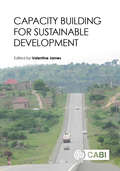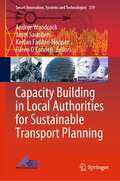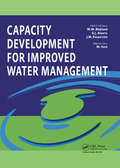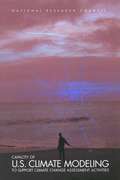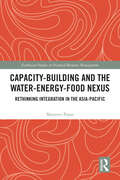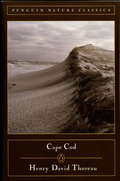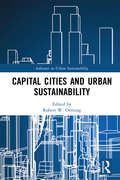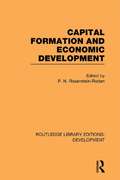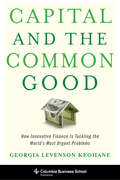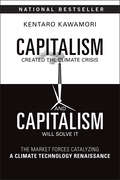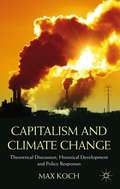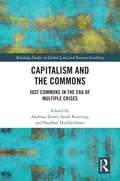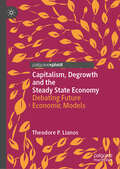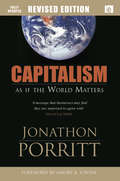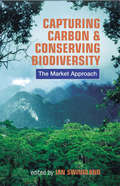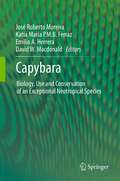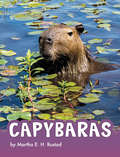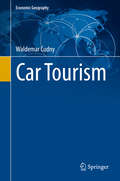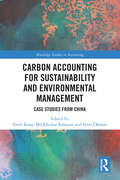- Table View
- List View
Capacity Building for Sustainable Development
by Capacity Building for Sustainable Development Valentine JamesCapacity building is a topic of intense focus in many industrialized countries. This book explores the theoretical underpinnings of capacity building to sustain the natural, cultural and human resources of communities. It reviews the extensive literature on capacity-building strategies and policies and examines the implications of sustainable development in communities around the world. The book's approach is both theoretical and applied. It offers methods of operationalizing sustainable development and sustainability theories and explores capacity building methods at different levels of government. Successful practices in non-governmental and governmental agency roles are examined. By considering the path towards embracing whole, or partial, sustainability, it provides a comprehensive analysis and examination of how to build capacity in tackling many development problems, especially those linked to infrastructure accumulation and land-use development. Contributors shed light on the overall impact of globalisation and many concepts related to sustainable development and sustainability of the economic socio-cultural and environmental systems. This book: · Examines the links between environment and sustainable development; · Provides models for capacity building; · Considers the role of globalization in sustainable development; · Renders a theoretical and applied examination of the issues; · Provides multidisciplinary and interdisciplinary approaches. This book is recommended for research libraries, for graduate studies in economic development, sustainable development, environmental management; and undergraduate studies relating to developing and emerging countries. It is also useful for government officials, researchers, decision makers and policy analysts involved in sustainable development.
Capacity Building for Sustainable Development
by Valentine JamesCapacity building is a topic of intense focus in many industrialized countries. This book explores the theoretical underpinnings of capacity building to sustain the natural, cultural and human resources of communities. It reviews the extensive literature on capacity-building strategies and policies and examines the implications of sustainable development in communities around the world. The book's approach is both theoretical and applied. It offers methods of operationalizing sustainable development and sustainability theories and explores capacity building methods at different levels of government. Successful practices in non-governmental and governmental agency roles are examined. By considering the path towards embracing whole, or partial, sustainability, it provides a comprehensive analysis and examination of how to build capacity in tackling many development problems, especially those linked to infrastructure accumulation and land-use development. Contributors shed light on the overall impact of globalization and many concepts related to sustainable development and sustainability of the economic socio-cultural and environmental systems. This book: - Examines the links between environment and sustainable development; - Provides models for capacity building; - Considers the role of globalization in sustainable development; - Renders a theoretical and applied examination of the issues; - Provides multidisciplinary and interdisciplinary approaches. This book is recommended for research libraries, for graduate studies in economic development, sustainable development, environmental management; and undergraduate studies relating to developing and emerging countries. It is also useful for government officials, researchers, decision makers and policy analysts involved in sustainable development.
Capacity Building in Local Authorities for Sustainable Transport Planning (Smart Innovation, Systems and Technologies #319)
by Andree Woodcock Janet Saunders Keelan Fadden-Hopper Eileen O’ConnellThis book is conceptualized as being of interest to researchers in the field of sustainable transport, and also those who are working in the field. In the first case it will provide a reference on the state of the art of sustainable transport, and will also include insights into an EU project, how to go about delivering impact, how such projects effect local authorities, etc. Sustainable transport is an extreme growth area; it is highly innovative, with multi-million-pound investments transforming cities. The book will help and encourage resource poor small to medium local authorities catch up and meet their sustainability targets.
Capacity Development for Improved Water Management
by M.W. Blokland, G.J. Alaerts, J.M. Kaspersma and M. HareThis collection of papers explains how knowledge and capacity development can contribute to improved, effective water management with a digest of lessons learned in the areas of development of tools and techniques, field applications and evaluation. The authors are prominent practitioners, capacity builders and academics within the water and capacity development sectors.Capacity Development for Improved Water Management starts with an introduction and overview of progress and challenges in knowledge and capacity development in the water sector. The next part presents tools and techniques that are being used in knowledge and capacity development in response to the prevailing challenges in the water sector, and a review of experience with capacity change in other sectors. In the third part a number of cases are presented that cover knowledge and capacity development experiences in the water resources and water services sectors. This part also presents experiences on water education for children and on developing gender equity. The fourth part provides experiences with the monitoring and evaluation of knowledge and capacity building.
Capacity of U.S. Climate Modeling to Support Climate Change Assessment Activities
by Climate Research CommitteeInformation on the Capacity of U.S. Climate Modeling to Support Climate Change Assessment Activities
Capacity-Building and the Water-Energy-Food Nexus: Rethinking Integration in the Asia-Pacific (Earthscan Studies in Natural Resource Management)
by Maureen PapasCritically analysing methodologies and objectives of capacity building and the practical linkages required to achieve the Sustainable Development Goals, this book looks at whether nexus thinking offers a systematic approach to combat global environmental problems and facilitate enhanced sustainable development. Building effective and sustainable mechanisms to tackle environmental problems requires in-depth understanding of relationships between natural resources, going beyond conventional policy and siloed decision making. The water energy food nexus has been promoted as a conceptual framework and management tool to facilitate integrated planning and practical linkages to support sustainable development. The author opens this book with an overview of capacity building and reviews the significance of the water energy food nexus, bringing in links to the 2030 Agenda. Climate change is highlighted as a key consideration in any conversation about natural resource use and case studies from Japan, India and China are utilised to show that whist long-term sustainable development practices are being implemented the environmental challenges across the region raise concerns about institutional capacity, economic sustainability and future of the region. Finally, through the lens of capacity building, the book suggests that whilst the water energy food nexus may provide a new approach to sustainable development, it will not be enough to achieve long-term sustainability or extend to the lives of those most affected. The book will be interest to scholars and students within the water, energy and agriculture sectors, sustainability governance and sustainable development. It will also be a valuable resource to those working in governmental organisations and NGOs involved in capacity building and development.
Cape Cod
by Henry David Thoreau Paul TherouxThoreau's classic account of his meditative, beach-combing walking trips to Cape Cod in the early 1850s, reflecting on the elemental forces of the sea Cape Cod chronicles Henry David Thoreau's journey of discovery along this evocative stretch of Massachusetts coastline, during which time he came to understand the complex relationship between the sea and the shore. He spent his nights in lighthouses, in fishing huts, and on isolated farms. He passed his days wandering the beaches, where he observed the wide variety of life and death offered up by the ocean. Through these observations, Thoreau discovered that the only way to truly know the sea--its depth, its wildness, and the natural life it contained--was to study it from the shore. Like his most famous work, Walden, Cape Cod is full of Thoreau's unique perceptions and precise descriptions. But it is also full of his own joy and wonder at having stumbled across a new frontier so close to home, where a man may stand and "put all America behind him." Part of the Penguin Nature Library Series Editor: Edward Hoagland With an Introduction by Paul Theroux
Cape Cod and the Portland Gale of 1898 (Disaster)
by Donald WildingOn the night of November 26, 1898, with a killer storm of historic proportions approaching, the steamer Portland set out from Boston. By the following night, the winter hurricane sent the vessel to the depths of Massachusetts Bay off Cape Cod, claiming nearly two hundred lives. On the Cape, a few dozen victims of the Portland disaster washed ashore, while ships piled up in harbors, high tides swept away railroad tracks, and the landscape and beaches were changed forever. Several Cape Cod mariners went to sea and never returned, caught in the gale's evil clutches. Local author Don Wilding revisits this disaster and the heroic deeds of the U.S. Life-Saving Service and the Cape's citizenry in what came to be known as "The Portland Gale."
Cape Hatteras Lighthouse (Images of America)
by Douglas Stover Mary Ellen RiddleThe Cape Hatteras Lighthouse, standing 198.49 feet, is the tallest brick lighthouse in the United States. From 1803, when the first Cape Hatteras Lighthouse was built, to today, it cast its light over the waters off the Outer Banks of North Carolina, also called the "Graveyard of the Atlantic." Its history--stretching from Augustin-Jean Fresnel's lens laboratory in France to the beaches of Hatteras Island where the lighthouse keepers labored--includes war, shipwrecks, hurricanes, and cutting-edge technology. Due to politics, funding, and its precarious location, it took great effort to erect and protect a lighthouse built on a barrier island. The supporters and caretakers were many, including Alexander Hamilton in the 1700s and children donating coins to a statewide preservation campaign in 1982. In the 21st century, the Cape Hatteras Lighthouse continues to send out its beam to mariners.
Cape Hatteras National Seashore
by Doug StoverCape Hatteras National Seashore was authorized by Congress on August 17, 1937, and established on January 12, 1953. As the nation's first national seashore, it encompasses 30,000 acres and crosses three islands, Bodie, Hatteras, and Ocracoke, for approximately 70 miles. Nearby Pea Island National Wildlife Refuge, located within the authorized seashore boundary, is 5,880 acres. Over the centuries, the seashore has witnessed major historic events, including the landing of the first English explorers, the death of Blackbeard the pirate, Civil War battles, German U-boat attacks, hundreds of shipwrecks, and devastating hurricanes. Descended from horses brought over by Spanish explorers, the Ocracoke ponies still roam the landscape. This National Park Service unit also includes the majestic Bodie Island, Cape Hatteras, and Ocracoke Lighthouses. The seashore is a haven for wildlife and recreational beachgoers. Cape Hatteras National Seashore showcases the rich natural and cultural heritage of America's first national seashore.
Capital Cities and Urban Sustainability (Advances in Urban Sustainability)
by Robert W. OrttungCapital Cities and Urban Sustainability examines how capital cities use their unique hub resources to develop and disseminate innovative policy solutions to promote sustainability. Cities are taking a leading role in defining a sustainable future at a time when national, state, and regional governments in several countries do not provide sufficient leadership. Capital cities stand out among cities as likely leading drivers in the effort to empower sustainable innovation as they provide a hub for connecting a variety of key constituencies. While acknowledging the successes capital cities have achieved, the international, multi-disciplinary contributors to this work discuss how there is room to do more and improve. The promotion of specific sustainability policies in crucial areas such as clean water provision, high tech innovation, public procurement contracting, and improving flood control in capital cities is examined through various global case studies. The examples range from relatively rich capital cities, such as Copenhagen, where the well-financed hub would be expected to succeed in generating sustainable policies, to poorer cities such as Phnom Penh, where such an optimistic outcome can seem less likely.
Capital Formation and Economic Development: Studies in the Economic Development of India (Routledge Library Editions: Development)
by P. N. Rosenstein-RodanFirst published in 1964, this series of studies, compiled by the India team of Centre of International Studies at MIT, represents an important contribution to methods in planning for development, which will be of relevance to all those working in the field, irrespective of country. The results are demonstrated on examples taken from the Third Five-Year Plan and from some of the papers which underlay it.
Capital and the Common Good: How Innovative Finance Is Tackling the World's Most Urgent Problems (Columbia Business School Publishing)
by Georgia Levenson KeohaneDespite social and economic advances around the world, poverty and disease persist, exacerbated by the mounting challenges of climate change, natural disasters, political conflict, mass migration, and economic inequality. While governments commit to addressing these challenges, traditional public and philanthropic dollars are not enough. Here, innovative finance has shown a way forward: by borrowing techniques from the world of finance, we can raise capital for social investments today. Innovative finance has provided polio vaccines to children in the DRC, crop insurance to farmers in India, pay-as-you-go solar electricity to Kenyans, and affordable housing and transportation to New Yorkers. It has helped governmental, commercial, and philanthropic resources meet the needs of the poor and underserved and build a more sustainable and inclusive prosperity. Capital and the Common Good shows how market failure in one context can be solved with market solutions from another: an expert in securitization bundles future development aid into bonds to pay for vaccines today; an entrepreneur turns a mobile phone into an array of financial services for the unbanked; and policy makers adapt pay-for-success models from the world of infrastructure to human services like early childhood education, maternal health, and job training. Revisiting the successes and missteps of these efforts, Georgia Levenson Keohane argues that innovative finance is as much about incentives and sound decision-making as it is about money. When it works, innovative finance gives us the tools, motivation, and security to invest in our shared future.
Capitalism Created the Climate Crisis and Capitalism Will Solve It: The Market Forces Catalyzing a Climate Technology Renaissance
by Kentaro KawamoriCreative and practical free-market solutions to climate change In Capitalism Created the Climate Crisis and Capitalism Will Solve It: The Market Forces Catalyzing a Climate Technology Renaissance, distinguished author Kentaro Kawamori delivers a fascinating and timely exploration of the interplay between capitalism and climate change. He explains how the capitalist system helped to contribute to the current crisis of global warming and how that same system will help to end it. In the book, the author discusses the enormous impact of the climate crisis and how the government, the modern finance industry, the fossil fuel industry, and others combined to accelerate the warming of the world. He then considers the roles those same players will play to reverse this effect in the coming years. You’ll also find: Discussions of how climate tech innovations will transform the economy and how technology disruptors will become involved in the process The ways the energy industry will change to incorporate the realities and consequences of a warming climate Explorations of the incentives created by free market structures and how to include climate stakeholders in the discussionAn engaging and exciting new resource for anyone interested in the intersection of economics, business, and the environment, Capitalism Created the Climate Crisis and Capitalism Will Solve It contains practical and thoughtful climate prescriptions for a world desperately in need of them.
Capitalism and Climate Change: Theoretical Discussion, Historical
by Max KochThis book discusses climate change as a social issue, examining the incompatibility of capitalist development and Earth's physical limits and how these have been regulated in different ways. It addresses the links between modes of consumption, energy regimes and climate change during Fordism and finance-driven capitalism.
Capitalism and the Commons: Just Commons in the Era of Multiple Crises (Routledge Studies in Global Land and Resource Grabbing)
by Andreas Exner Sarah Kumnig Stephan HochleithnerCapitalism and the Commons focuses on the political and social perspectives that commons offer, how they are appropriated or suppressed by capital and state, and how social initiatives and movements contest these dynamics or build their struggles on commoning. The volume comprises theoretical and empirical approaches that engage with three main themes: conceptualizing the commons, analyzing practices of commoning, and exploring commons politics. In their contributions, the authors focus on the development of anti-capitalist commons and explore the issue of practice and politics through case studies from Colombia, the Democratic Republic of Congo, South Africa, and Africa more broadly, Austria, Germany and South Korea, ranging from peri-urban and rural agriculture to urban commons and how they manifest in the Global South as well as in the Global North. The book engages with different discourses on the commons in regard to their relevance for social change and thereby reinvigorates the political meaning of the commons. It provides an original and important approach to the topic in terms of conceptualization, detailing diverse empirical realities, and analyzing potential perspectives. In so doing, the book transcends narrow disciplinary boundaries and expands the focus to the global. Providing a fresh perspective on the commons as a decisive component of alternatives, this title will be relevant to scholars and students of resource management, social movements, and sustainable development more broadly.
Capitalism, Degrowth and the Steady State Economy: Debating Future Economic Models (Palgrave Insights into Apocalypse Economics)
by Theodore P. LianosThis book examines the contemporary state of the capitalist economyand its future trajectory in a world characterized by multiple crises from population growth to ecological damage. Setting an understanding of modern capitalism in global historical context, chapters consider the uncertainty of capitalism’s future and argues that capitalism must adapt dramatically to survive.. The book examines the major problems that a capitalist system faces, including inequality, organized crime, uncontrolled technological development, polarizing geopolitics, food security and climate change. To address these multifaceted challenges andminimize the impact of capitalism in exacerbating them, the book discusses the potential viability of a ‘steady state’ economic model and a de-growth approach to the global economy. It also considers various alternative models for the future, including eco-socialism and participatory socialism. This book deftly weaves together perspectives on a wide variety of issues and will be a useful resource for scholars interested in Marxist economics and heterodox economics, political economy, economic development and economic thought.
Capitalism: As If the World Matters
by Jonathon PorrittAs our great economic machine grinds relentlessly forward into a future of declining fossil fuel supplies, climate change and ecosystem failure, governments are at long last beginning to question the very structure of the global economy. In this fresh, politically charged analysis, Jonathon Porritt wades in on the most pressing question of the 21st century: can capitalism, as the only real economic game in town, be retooled to deliver a sustainable future? Porritt argues that indeed it can, and it must, as he lays out the framework for a new ?sustainable capitalism? that cuts across the political divide and promises a prosperous future of wealth, equity and ecosystem integrity.
Capitalizing on Nature
by Edward B. BarbierThe basic unit of nature - the ecosystem - is a special form of wealth, which we can think of as a stock of natural capital. However, perhaps because this capital is free, we have tended to view it as limitless, abundant and always available for our use, exploitation and conversion. Capitalizing on Nature shows how modeling ecosystems as natural capital can help us to analyze the economic behavior that has led to the overuse of so much ecological wealth. It explains how this concept of ecosystem as natural capital sheds light on a number of important issues, including landscape conversion, ecological restoration, ecosystem resilience and collapse, spatial benefits and payments for ecosystem services. The book concludes by focusing on major policy challenges that need to be overcome in order to avert the worsening problem of ecological scarcity and how we can fund novel financing mechanisms for global conservation.
Capturing Carbon and Conserving Biodiversity: The Market Approach
by Ian R. SwinglandFor decades conservation has been based on the donor-driven principle. It hasn't worked. For centuries, environmental pollution or degradation has been addressed by the same attitude: the 'Polluter Pays' principle. That hasn't worked either. The cycle has to stop. But while everyone talks about using a market-driven approach, few know how to do it. Faced with the situation on the ground what do you do? What is happening? How can you engage a system so that it is self-sustaining and the people self-motivated? This study explores how the growing market in carbon can help to conserve carbon-based life forms. It discusses how reducing global warming and saving biodiversity can both be achieved with the right market conditions. The contributors include conservation biologists, ecologists, biologists, economists, lawyers, community and tribal specialists, financial specialists, market makers, environment specialists, climatologists, resource managers, atmospheric scientists, project developers and corporate fund managers.
Capybara: Biology, Use and Conservation of an Exceptional Neotropical Species
by Emilio A. Herrera David W. Macdonald José Roberto Moreira Katia Maria FerrazThe capybara is the neotropical mammal with the highest potential for production and domestication. Amongst the favorable characteristics for domestication we can list its high prolificacy, rapid growth rate, a herbivorous diet, social behavior and relative tameness. The genus (with only two species) is found from the Panama Canal to the north of Argentina on the east of the Andes. Chile is the only country in South America where the capybara is not found. The species is eaten all over its range, especially by poor, rural and traditional communities engaged in subsistence hunting. On the other hand, in large urban settlements wildlife is consumed by city dwellers as a delicacy. The sustainable management of capybara in the wild has been adopted by some South American countries, while others have encouraged capybara rearing in captivity.
Capybaras (Animals)
by Martha E. RustadCapybaras are the biggest rodents in the world! These social animals live in large groups and spend lots of time in water. Get all the facts on these huge rodents.
Car Tourism (Economic Geography)
by Waldemar CudnyThis book examines the role of cars and the space connected with their production and presentation in tourism development. It describes the role played by experiences and experience societies formed in the 20th c. in the development of contemporary tourism, including tourism related to cars. The book explores the influence of experiencing unusual events, such as car races, car fairs, visits to car industry museums or multifunctional spaces connected with producing and exhibiting cars (e. g. Autostadt or Audi Forum) on the development of a new type of tourism, i. e. car tourism. This kind of tourism is novel in two ways: firstly, it is a new phenomenon in science, as so far it has not been thoroughly studied or described, apart from various short articles. Secondly, this type of tourism has developed on a large scale only in recent years, mainly due to the huge investments made by powerful European car manufacturers (e. g. Autostadt, Audi Forums, Porsche Museum, Lamborghini Museum etc. ). The book presents cars and the spaces related to them as tourist assets (sites, events) and as tourist products that satisfy tourists' needs. Moreover, it connects the issue of car tourism to the marketing strategies of large car manufacturers and discusses the theory of tourism space, highlighting the main tourism spaces in which car tourism develops. It presents multifunctional spaces (factories, adventure centres - Autostadt in Wolfsburg), museums, car exhibitions, and race tracks. In the next chapter, following an introduction to the problem of events, the author describes events related to car tourism, including races, rallies, driving schools and car fairs. The book ends with a summarizing chapter, which includes a model of the function of car tourism as a separate type of tourism, as well as a discussion presenting the main features, advantages and disadvantages of car tourism in the context of the tourism space theory.
Car-Free Los Angeles and Southern California
by Nathan LandauThe time has come for Car-Free Los Angeles and Southern California. The peril of global climate change dominates the headlines. In California almost 40% of greenhouse gases come from transportation. More and more people-especially young people-are realizing the current approach to mobility is not sustainable.Car-Free Los Angeles and Southern California is designed as a complete guide to a car-free vacation in Southern California, from the time travelers land or arrive until the time they leave. Car-Free Los Angeles and Southern California reveals how to get from the airport-or the train station or bus station-into town. For Los Angeles or Southern California residents, this book tells how to plug into the transit network and start traveling car-free to the local attractions.Contrary to old stereotypes, Southern California is a great place to travel car-free. It has a lovely train that travels along the coast. It has a ferry across the water to a town with a limit on the number of cars--Avalon on Catalina Island. There's a beautiful city that gives you discounts for traveling car-free. Los Angeles' buses go to the front door of world class museums, theatres, and shops. Disneyland will shuttle travelers from motels to the park.The book lists good places to stay that are transit accessible. Car-Free Los Angeles and Southern California discloses the terrific things to see and do in Southern California with detailed information on how to get there. Whether it's sightseeing, shopping, eating, visiting museums or something else altogether-Car-Free Los Angeles and Southern California will get you there.
Carbon Accounting for Sustainability and Environmental Management: Case Studies from China (Routledge Studies in Accounting)
by Tarek Rana Peter Öhman Md Jahidur RahmanAs the world increasingly focuses on sustainability and climate justice, this book sets the scene by establishing the significance of carbon accounting in today’s environmental management practices.It provides a comprehensive exploration of the subject, with a specific focus on the Chinese context and sheds light on how carbon accounting practices are being integrated into corporate and national strategies. While the book has a strong focus on empirical realities in China, its exploration of carbon accounting and environmental management holds international importance. The book bridges the gap between theory and practice, offering readers in-depth insights into the intricate dynamics of carbon accounting and its implications for sustainable development, drawing on data and case studies to provide practical insights into the effectiveness of various carbon accounting approaches and their impact on environmental sustainability. It focuses on the crucial role of the development of green accounting, its future growth, and its wider impact on climate change. Additionally, the book examines how accurate tracking and reporting of carbon emissions are integral to developing effective environmental strategies and evolving environmental policies. Accompanied by real-world case studies and actionable recommendations, this book is a valuable resource for anyone navigating the intricate landscape of carbon accounting and reporting, offering a road map to informed strategic decision-making and sustainable business practices.It will be particularly beneficial for professionals in environmental management, policy formulation, and corporate sustainability, as it translates complex carbon accounting concepts into tangible, practical strategies.
